University Learning Outcomes Assignment - Professional Development
VerifiedAdded on 2023/04/21
|6
|971
|351
Homework Assignment
AI Summary
This homework assignment addresses key concepts related to learning outcomes in a professional development context. The student's responses cover various aspects, including the features contributing to a source's credibility, the role of supporting material, and the distinction between thesis statements and specific purposes. The assignment also explores the differences between search engines and subject directories, and defines attitudes, beliefs, and values. Furthermore, it delves into audience analysis methods, the time needed for research, and the best types of supporting material for speeches. The student provides examples and analysis, referencing relevant academic sources to support their answers. The assignment showcases a comprehensive understanding of the subject matter, providing valuable insights into effective communication and professional development strategies.
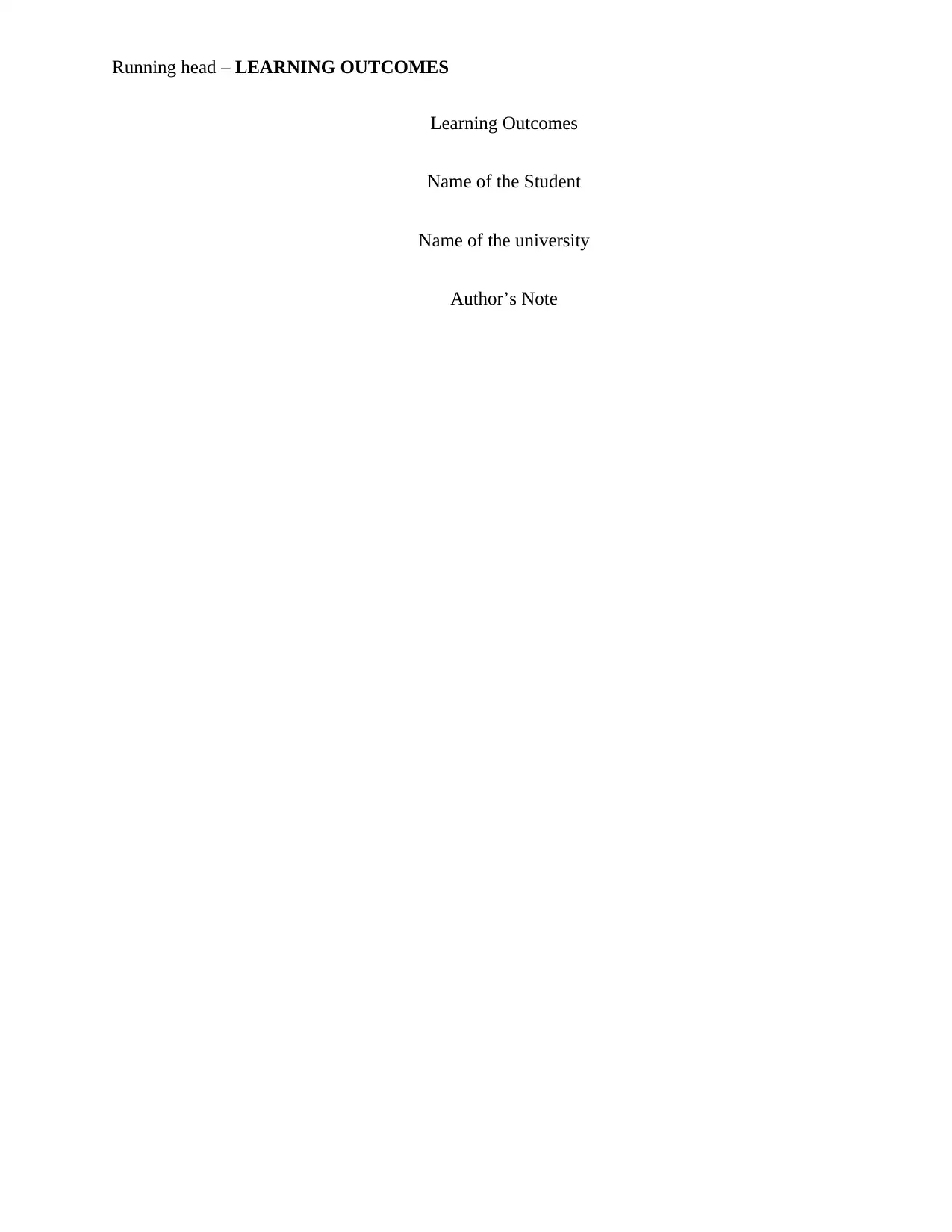
Running head – LEARNING OUTCOMES
Learning Outcomes
Name of the Student
Name of the university
Author’s Note
Learning Outcomes
Name of the Student
Name of the university
Author’s Note
Paraphrase This Document
Need a fresh take? Get an instant paraphrase of this document with our AI Paraphraser
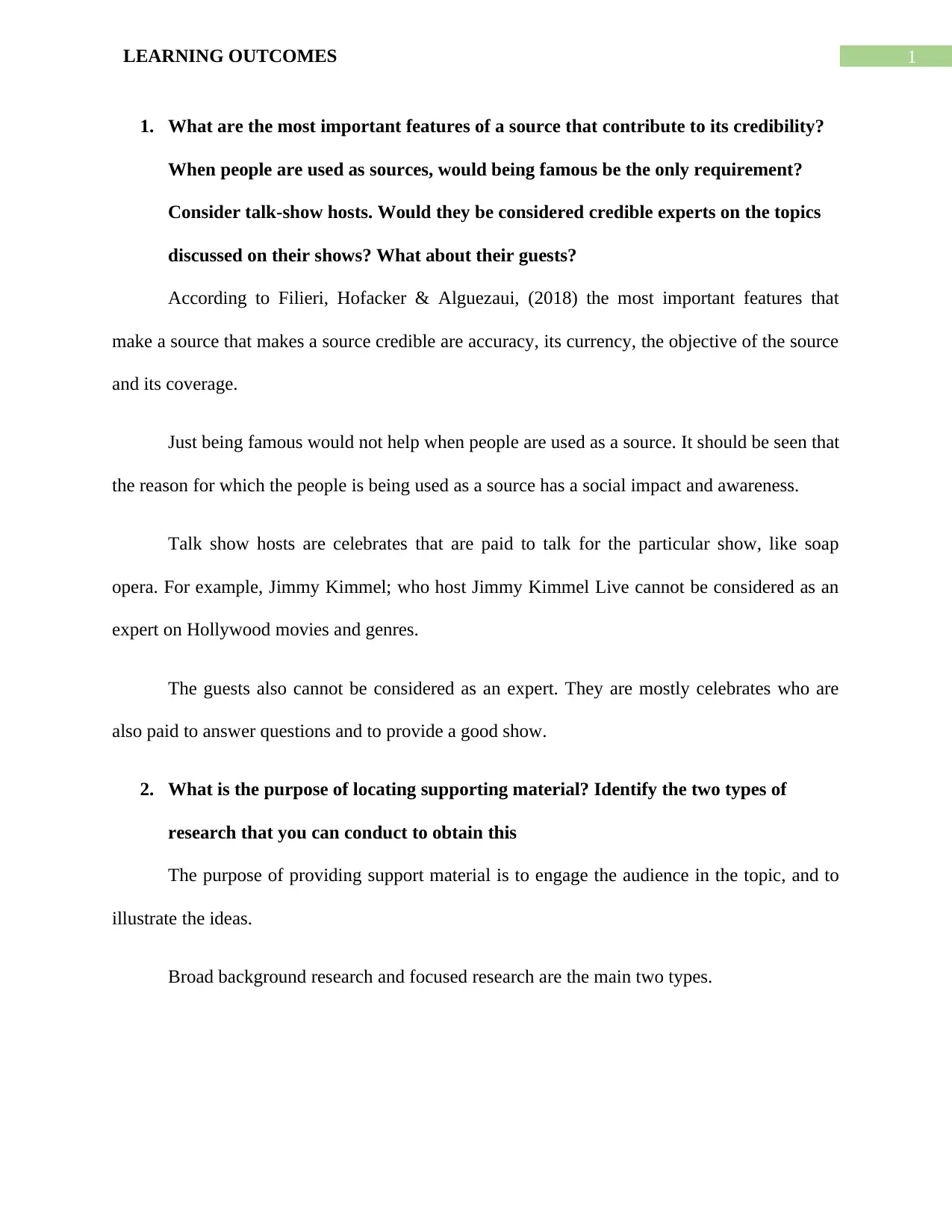
1LEARNING OUTCOMES
1. What are the most important features of a source that contribute to its credibility?
When people are used as sources, would being famous be the only requirement?
Consider talk-show hosts. Would they be considered credible experts on the topics
discussed on their shows? What about their guests?
According to Filieri, Hofacker & Alguezaui, (2018) the most important features that
make a source that makes a source credible are accuracy, its currency, the objective of the source
and its coverage.
Just being famous would not help when people are used as a source. It should be seen that
the reason for which the people is being used as a source has a social impact and awareness.
Talk show hosts are celebrates that are paid to talk for the particular show, like soap
opera. For example, Jimmy Kimmel; who host Jimmy Kimmel Live cannot be considered as an
expert on Hollywood movies and genres.
The guests also cannot be considered as an expert. They are mostly celebrates who are
also paid to answer questions and to provide a good show.
2. What is the purpose of locating supporting material? Identify the two types of
research that you can conduct to obtain this
The purpose of providing support material is to engage the audience in the topic, and to
illustrate the ideas.
Broad background research and focused research are the main two types.
1. What are the most important features of a source that contribute to its credibility?
When people are used as sources, would being famous be the only requirement?
Consider talk-show hosts. Would they be considered credible experts on the topics
discussed on their shows? What about their guests?
According to Filieri, Hofacker & Alguezaui, (2018) the most important features that
make a source that makes a source credible are accuracy, its currency, the objective of the source
and its coverage.
Just being famous would not help when people are used as a source. It should be seen that
the reason for which the people is being used as a source has a social impact and awareness.
Talk show hosts are celebrates that are paid to talk for the particular show, like soap
opera. For example, Jimmy Kimmel; who host Jimmy Kimmel Live cannot be considered as an
expert on Hollywood movies and genres.
The guests also cannot be considered as an expert. They are mostly celebrates who are
also paid to answer questions and to provide a good show.
2. What is the purpose of locating supporting material? Identify the two types of
research that you can conduct to obtain this
The purpose of providing support material is to engage the audience in the topic, and to
illustrate the ideas.
Broad background research and focused research are the main two types.
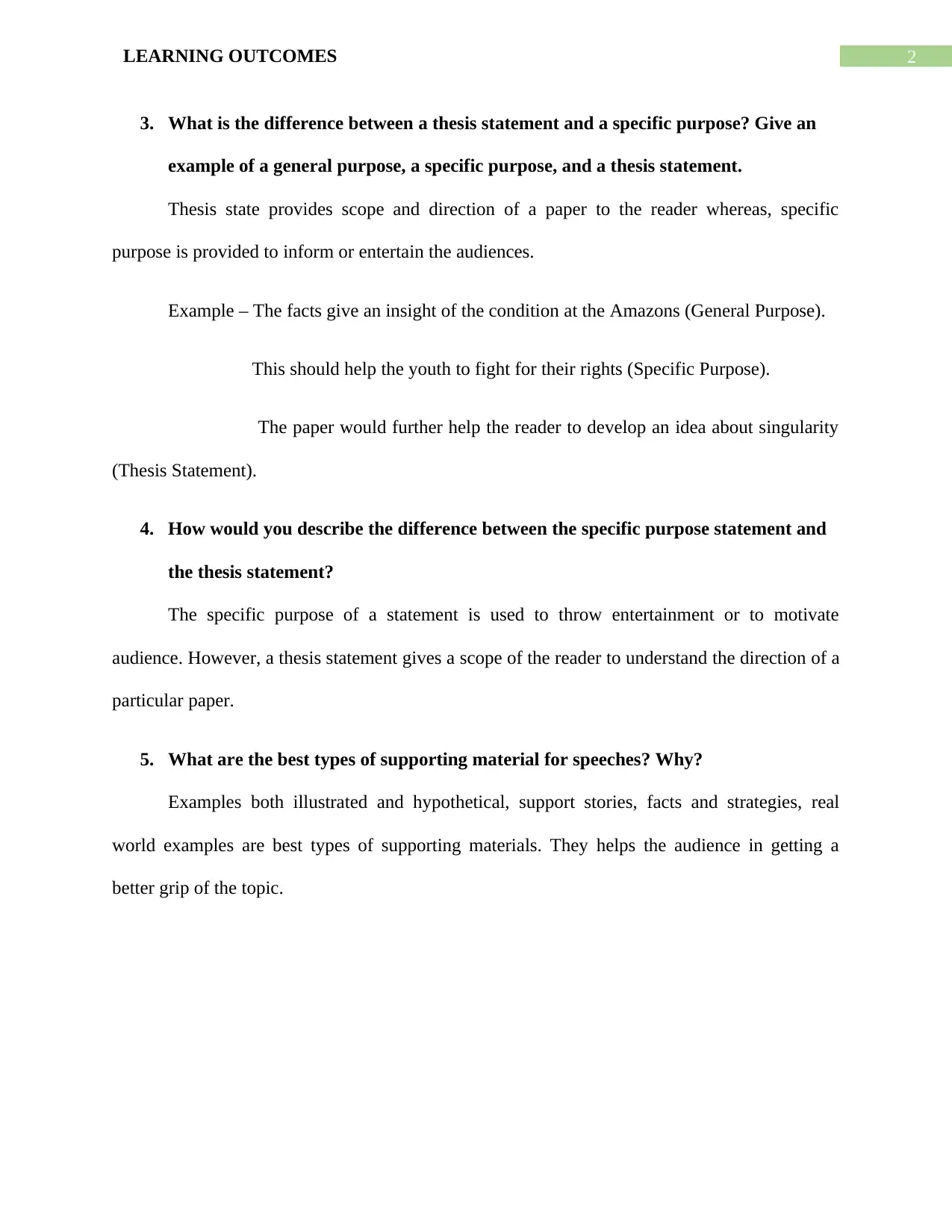
2LEARNING OUTCOMES
3. What is the difference between a thesis statement and a specific purpose? Give an
example of a general purpose, a specific purpose, and a thesis statement.
Thesis state provides scope and direction of a paper to the reader whereas, specific
purpose is provided to inform or entertain the audiences.
Example – The facts give an insight of the condition at the Amazons (General Purpose).
This should help the youth to fight for their rights (Specific Purpose).
The paper would further help the reader to develop an idea about singularity
(Thesis Statement).
4. How would you describe the difference between the specific purpose statement and
the thesis statement?
The specific purpose of a statement is used to throw entertainment or to motivate
audience. However, a thesis statement gives a scope of the reader to understand the direction of a
particular paper.
5. What are the best types of supporting material for speeches? Why?
Examples both illustrated and hypothetical, support stories, facts and strategies, real
world examples are best types of supporting materials. They helps the audience in getting a
better grip of the topic.
3. What is the difference between a thesis statement and a specific purpose? Give an
example of a general purpose, a specific purpose, and a thesis statement.
Thesis state provides scope and direction of a paper to the reader whereas, specific
purpose is provided to inform or entertain the audiences.
Example – The facts give an insight of the condition at the Amazons (General Purpose).
This should help the youth to fight for their rights (Specific Purpose).
The paper would further help the reader to develop an idea about singularity
(Thesis Statement).
4. How would you describe the difference between the specific purpose statement and
the thesis statement?
The specific purpose of a statement is used to throw entertainment or to motivate
audience. However, a thesis statement gives a scope of the reader to understand the direction of a
particular paper.
5. What are the best types of supporting material for speeches? Why?
Examples both illustrated and hypothetical, support stories, facts and strategies, real
world examples are best types of supporting materials. They helps the audience in getting a
better grip of the topic.
⊘ This is a preview!⊘
Do you want full access?
Subscribe today to unlock all pages.

Trusted by 1+ million students worldwide
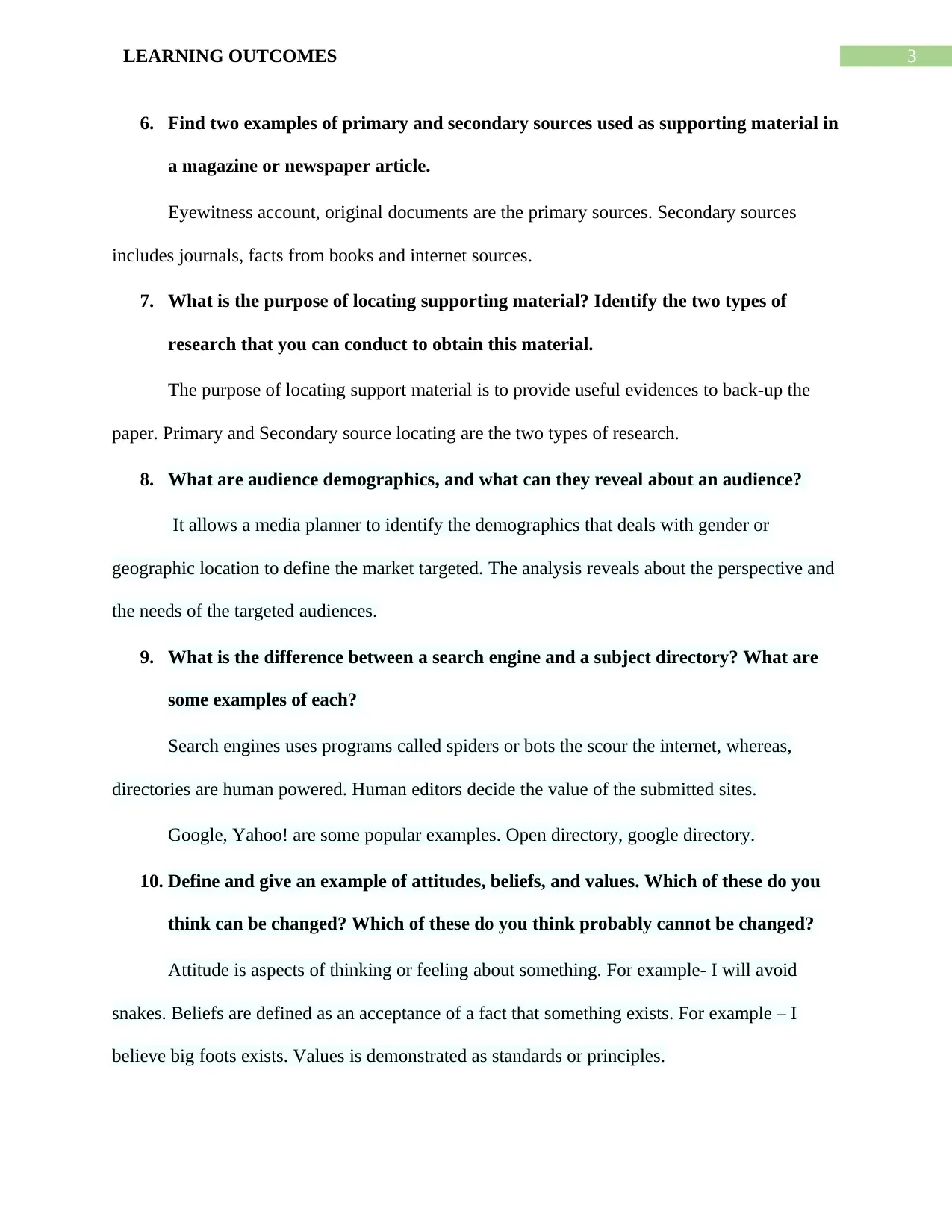
3LEARNING OUTCOMES
6. Find two examples of primary and secondary sources used as supporting material in
a magazine or newspaper article.
Eyewitness account, original documents are the primary sources. Secondary sources
includes journals, facts from books and internet sources.
7. What is the purpose of locating supporting material? Identify the two types of
research that you can conduct to obtain this material.
The purpose of locating support material is to provide useful evidences to back-up the
paper. Primary and Secondary source locating are the two types of research.
8. What are audience demographics, and what can they reveal about an audience?
It allows a media planner to identify the demographics that deals with gender or
geographic location to define the market targeted. The analysis reveals about the perspective and
the needs of the targeted audiences.
9. What is the difference between a search engine and a subject directory? What are
some examples of each?
Search engines uses programs called spiders or bots the scour the internet, whereas,
directories are human powered. Human editors decide the value of the submitted sites.
Google, Yahoo! are some popular examples. Open directory, google directory.
10. Define and give an example of attitudes, beliefs, and values. Which of these do you
think can be changed? Which of these do you think probably cannot be changed?
Attitude is aspects of thinking or feeling about something. For example- I will avoid
snakes. Beliefs are defined as an acceptance of a fact that something exists. For example – I
believe big foots exists. Values is demonstrated as standards or principles.
6. Find two examples of primary and secondary sources used as supporting material in
a magazine or newspaper article.
Eyewitness account, original documents are the primary sources. Secondary sources
includes journals, facts from books and internet sources.
7. What is the purpose of locating supporting material? Identify the two types of
research that you can conduct to obtain this material.
The purpose of locating support material is to provide useful evidences to back-up the
paper. Primary and Secondary source locating are the two types of research.
8. What are audience demographics, and what can they reveal about an audience?
It allows a media planner to identify the demographics that deals with gender or
geographic location to define the market targeted. The analysis reveals about the perspective and
the needs of the targeted audiences.
9. What is the difference between a search engine and a subject directory? What are
some examples of each?
Search engines uses programs called spiders or bots the scour the internet, whereas,
directories are human powered. Human editors decide the value of the submitted sites.
Google, Yahoo! are some popular examples. Open directory, google directory.
10. Define and give an example of attitudes, beliefs, and values. Which of these do you
think can be changed? Which of these do you think probably cannot be changed?
Attitude is aspects of thinking or feeling about something. For example- I will avoid
snakes. Beliefs are defined as an acceptance of a fact that something exists. For example – I
believe big foots exists. Values is demonstrated as standards or principles.
Paraphrase This Document
Need a fresh take? Get an instant paraphrase of this document with our AI Paraphraser
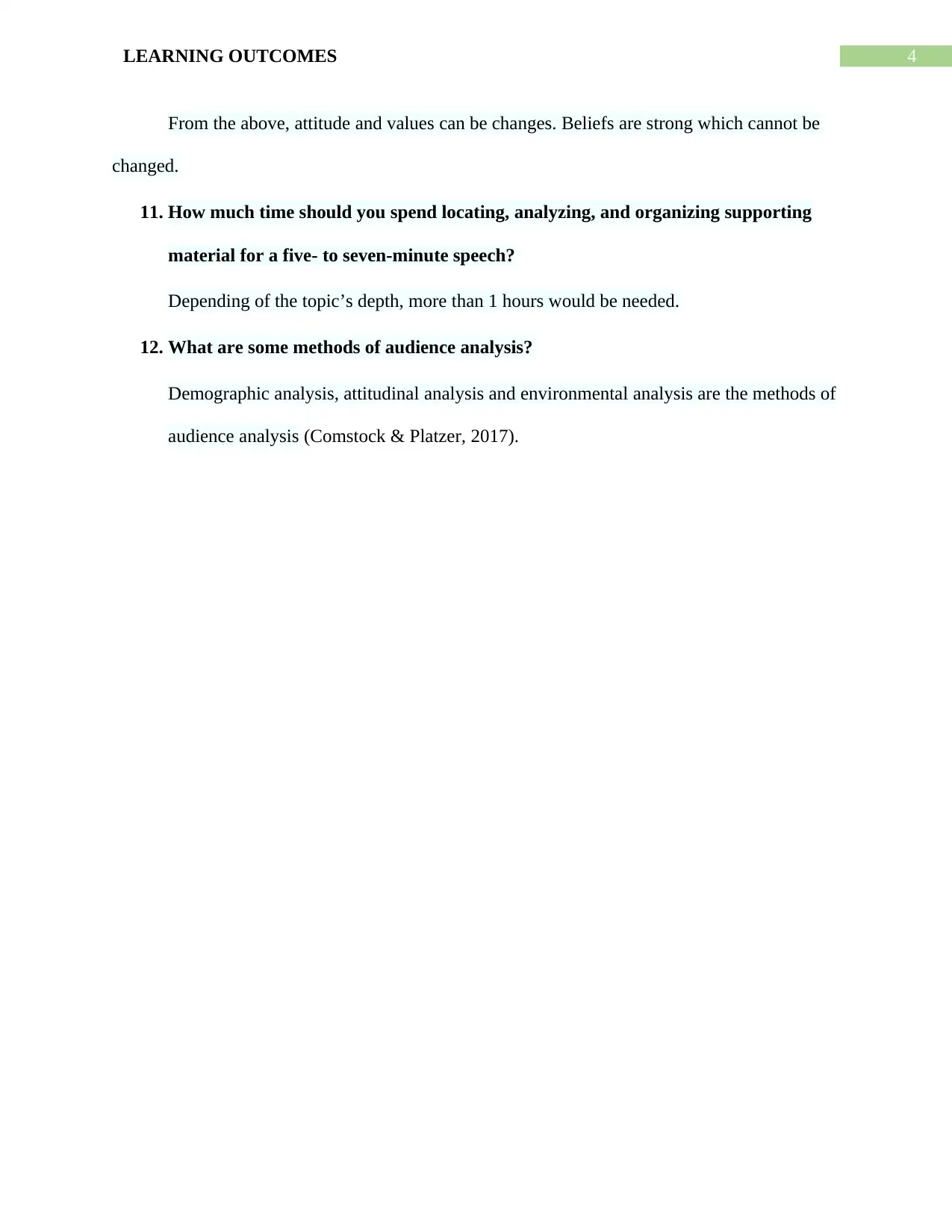
4LEARNING OUTCOMES
From the above, attitude and values can be changes. Beliefs are strong which cannot be
changed.
11. How much time should you spend locating, analyzing, and organizing supporting
material for a five- to seven-minute speech?
Depending of the topic’s depth, more than 1 hours would be needed.
12. What are some methods of audience analysis?
Demographic analysis, attitudinal analysis and environmental analysis are the methods of
audience analysis (Comstock & Platzer, 2017).
From the above, attitude and values can be changes. Beliefs are strong which cannot be
changed.
11. How much time should you spend locating, analyzing, and organizing supporting
material for a five- to seven-minute speech?
Depending of the topic’s depth, more than 1 hours would be needed.
12. What are some methods of audience analysis?
Demographic analysis, attitudinal analysis and environmental analysis are the methods of
audience analysis (Comstock & Platzer, 2017).
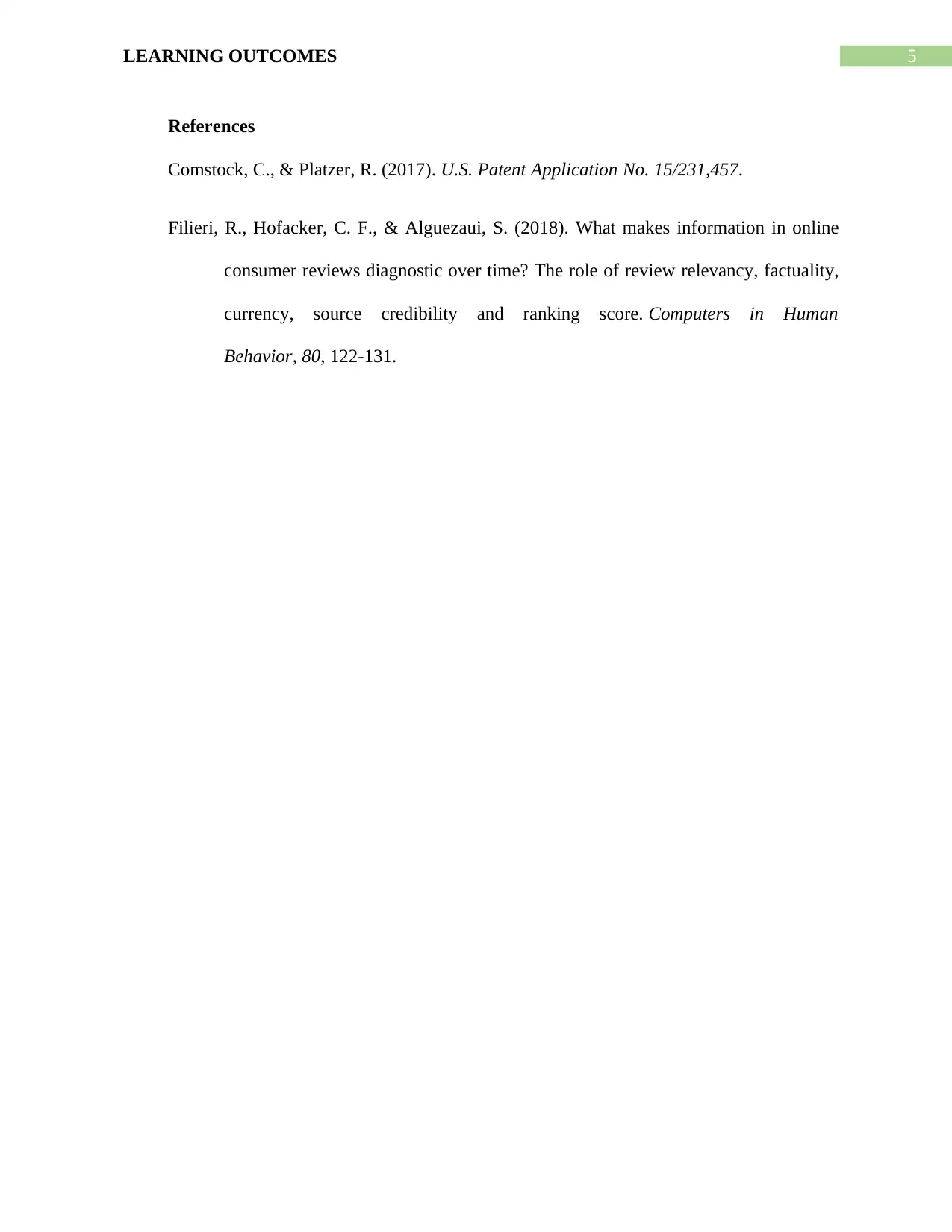
5LEARNING OUTCOMES
References
Comstock, C., & Platzer, R. (2017). U.S. Patent Application No. 15/231,457.
Filieri, R., Hofacker, C. F., & Alguezaui, S. (2018). What makes information in online
consumer reviews diagnostic over time? The role of review relevancy, factuality,
currency, source credibility and ranking score. Computers in Human
Behavior, 80, 122-131.
References
Comstock, C., & Platzer, R. (2017). U.S. Patent Application No. 15/231,457.
Filieri, R., Hofacker, C. F., & Alguezaui, S. (2018). What makes information in online
consumer reviews diagnostic over time? The role of review relevancy, factuality,
currency, source credibility and ranking score. Computers in Human
Behavior, 80, 122-131.
⊘ This is a preview!⊘
Do you want full access?
Subscribe today to unlock all pages.

Trusted by 1+ million students worldwide
1 out of 6
Related Documents
Your All-in-One AI-Powered Toolkit for Academic Success.
+13062052269
info@desklib.com
Available 24*7 on WhatsApp / Email
![[object Object]](/_next/static/media/star-bottom.7253800d.svg)
Unlock your academic potential
Copyright © 2020–2025 A2Z Services. All Rights Reserved. Developed and managed by ZUCOL.


